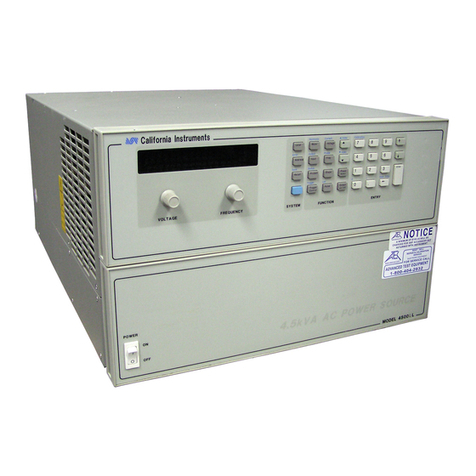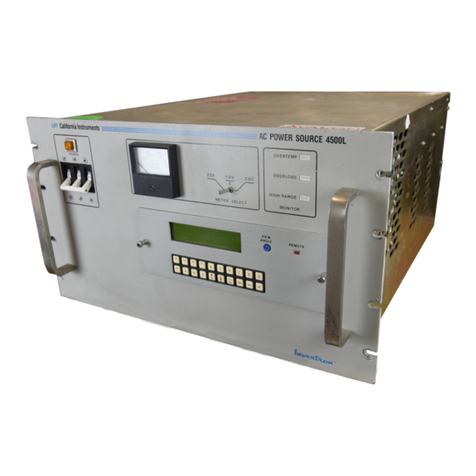
User and Programming Manual - Rev P California Instruments
Table of Contents
1. Introduction................................................................................................................................. 1
1.1. General Description...................................................................................................................................1
2. Specifications............................................................................................................................. 2
2.1. Electrical....................................................................................................................................................2
2.2. Mechanical................................................................................................................................................5
2.3. Environmental ...........................................................................................................................................6
2.4. Regulatory.................................................................................................................................................6
2.5. Front Panel Controls .................................................................................................................................7
2.6. Available Options ......................................................................................................................................7
3. Unpacking and Installation......................................................................................................... 8
3.1. Unpacking.................................................................................................................................................8
3.2. Power Requirements.................................................................................................................................8
3.3. Mechanical Installation..............................................................................................................................8
3.4. Input Wiring...............................................................................................................................................9
3.5. Output Connections...................................................................................................................................9
3.6. Output Voltage Ranges........................................................................................................................... 10
3.7. Functional Test........................................................................................................................................ 10
4. Front Panel Operation.............................................................................................................. 12
4.1. Front Panel Guided Tour......................................................................................................................... 12
4.2. How to..................................................................................................................................................... 16
5. Principle of Operation............................................................................................................... 19
5.1. General ................................................................................................................................................... 19
5.2. Overall Description.................................................................................................................................. 19
5.3. Power Factor Correction Module (PFC).................................................................................................. 19
5.4. DC - DC Converter Module..................................................................................................................... 20
5.5. 20
5.6. Oscillator Control Board.......................................................................................................................... 21
5.7. DC to AC Power Module ......................................................................................................................... 22
5.8. IEEE 488/ RS232.................................................................................................................................... 22
6. Calibration................................................................................................................................ 24
6.1. Calibration Equipment............................................................................................................................. 24
6.2. Routine Calibration.................................................................................................................................. 24
6.3. Non-Routine Calibration.......................................................................................................................... 27
7. Service ..................................................................................................................................... 29
7.1. General ................................................................................................................................................... 29
7.2. Basic Operation....................................................................................................................................... 29
7.3. Advanced Troubleshooting...................................................................................................................... 31
8. Introduction to PGUI32............................................................................................................. 34
8.1. About This Program ................................................................................................................................ 34
8.2. About This Section of the Manual ........................................................................................................... 34
8.3. Program Requirements........................................................................................................................... 34
8.4. RS232C Cable Wiring............................................................................................................................. 35
9. PGUI32 Setup and Installation................................................................................................. 36
9.1. Connecting the AC Source to the PC When Using RS232...................................................................... 36
9.2. Connecting the AC Source to the PC Using IEEE-488............................................................................ 36
9.3. Installing the PGUI32 Software ............................................................................................................... 36
9.4. Trouble Shooting - RS232C .................................................................................................................... 37
9.5. Registration............................................................................................................................................. 39
iv October 2005 RP Series
































